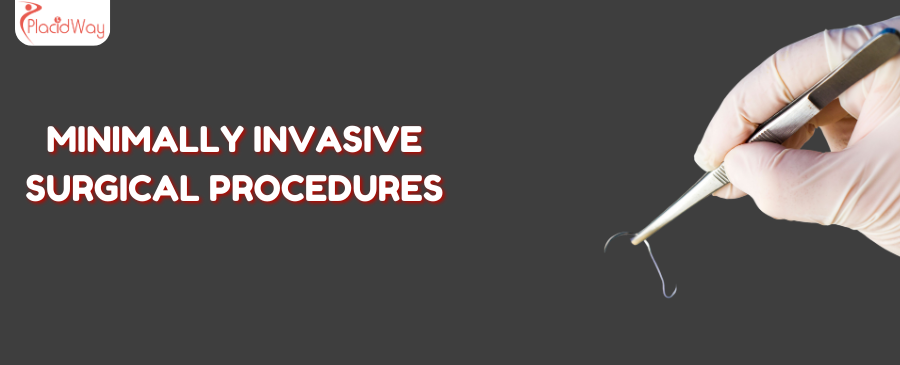
Discover Minimally Invasive Surgery Abroad: Your Path to Faster Healing & Less Discomfort
Facing surgery can be a daunting prospect, often bringing concerns about pain, lengthy recovery times, and significant disruption to your life. What if there was an option that promised less discomfort, smaller scars, and a quicker return to your daily routine? This is the promise of Minimally Invasive Surgical Procedures (MIS), a revolutionary approach transforming modern healthcare.
Minimally Invasive Surgery encompasses a variety of techniques that allow surgeons to operate through tiny incisions, often just a few millimeters long, rather than the large cuts associated with traditional "open" surgery. Instead of a surgeon's hands, specialized instruments and a high-definition camera are inserted, giving the medical team a clear, magnified view of the operating area on a monitor. This innovative method is often referred to by specific names such as laparoscopic surgery, robotic surgery, or arthroscopic surgery, depending on the body part and tools used.
For patients, the benefits are compelling: significantly reduced pain, less blood loss, lower risk of infection, minimal scarring, shorter hospital stays, and a much faster recovery period. These advantages have made MIS an increasingly popular choice, not just domestically, but for those exploring medical tourism. Patients from around the globe are searching for "affordable minimally invasive surgery," "best countries for MIS," and "MIS procedures explained" to access cutting-edge care that aligns with their health and financial needs.
Whether you're struggling with persistent pain from a hernia, dealing with gallstones, or facing joint issues, MIS offers a sophisticated solution designed to get you back on your feet sooner. This guide will explore everything you need to know about these advanced procedures, including common conditions they treat, what to expect, and why choosing to undergo MIS abroad could be a life-changing decision.
What conditions are treated with minimally invasive surgical procedures?
Minimally invasive surgery has revolutionized how many common and complex conditions are treated. Instead of a single large incision, multiple small incisions (typically 0.5 to 1.5 cm) are used, through which specialized instruments and a high-definition camera are inserted. This approach is now standard for a variety of conditions, addressing patient concerns about recovery and scarring. Common procedures include:
- Gallbladder Removal (Cholecystectomy): Often performed laparoscopically to remove gallstones causing pain or inflammation.
- Hernia Repair: Laparoscopic repair of inguinal, umbilical, or hiatal hernias, strengthening weakened abdominal walls.
- Appendectomy: Minimally invasive removal of an inflamed appendix.
- Hysterectomy: Laparoscopic or robotic removal of the uterus for conditions like fibroids, endometriosis, or abnormal bleeding.
- Myomectomy: Laparoscopic or robotic removal of uterine fibroids while preserving the uterus.
- Bariatric Surgery: Procedures like gastric bypass and sleeve gastrectomy are almost exclusively performed using minimally invasive techniques.
- Joint Surgeries (Arthroscopy): Repair of knee, shoulder, hip, or ankle injuries (e.g., meniscus repair, rotator cuff repair) through small incisions.
- Colon and Rectal Surgery: For conditions like diverticulitis, colon cancer, or inflammatory bowel disease.
- Urological Procedures: Prostatectomy (prostate removal), kidney stone removal, and partial nephrectomy (kidney tumor removal).
- Thoracic Surgery: Lung biopsies, removal of lung nodules, or treatment of conditions like pleurisy.
Patients often search for "laparoscopic surgery for gallbladder," "robotic hysterectomy benefits," or "arthroscopy recovery time" to understand how these advanced techniques apply to their specific health concerns.
What causes the need for surgery, and how does MIS help?
Surgical intervention becomes necessary when medical management is insufficient to resolve a condition. The "why" behind needing surgery varies widely:
- Inflammation or Infection: Conditions like appendicitis (inflamed appendix) or cholecystitis (inflamed gallbladder) often require urgent removal.
- Structural Defects: Hernias occur when an organ or fatty tissue protrudes through a weak spot in surrounding muscle or connective tissue.
- Benign Growths: Uterine fibroids, benign tumors in the uterus, can cause pain, heavy bleeding, or pressure.
- Malignant Growths (Cancer): Surgical removal of cancerous tumors is a common treatment for various cancers.
- Organ Dysfunction: Severe obesity leading to metabolic diseases might necessitate bariatric surgery to improve health outcomes.
- Injuries and Degeneration: Torn ligaments or cartilage in joints (e.g., meniscus tears, rotator cuff tears) due to trauma or wear-and-tear.
Minimally Invasive Surgery helps by providing a precise and less invasive way to correct these issues. For example, instead of a large incision to repair a hernia, MIS uses small ports, allowing surgeons to visualize and mend the defect with specialized instruments, reducing muscle damage and postoperative pain. This precision also contributes to less blood loss and a lower risk of infection, directly addressing patient anxieties about surgical impact.
What types of minimally invasive surgical procedures are available?
The umbrella term "minimally invasive surgery" encompasses several distinct techniques, each tailored to specific body areas and surgical needs:
- Laparoscopic Surgery: Perhaps the most well-known, this technique is used for abdominal and pelvic procedures. A laparoscope (a thin, lighted tube with a camera) is inserted through a small incision, and other small incisions are used for surgical instruments. This is commonly used for gallbladder removal, hernia repair, and gynecological surgeries.
- Thoracoscopic Surgery (VATS - Video-Assisted Thoracoscopic Surgery): Similar to laparoscopy but used for procedures within the chest cavity, such as lung biopsies, removal of lung tumors, or pleurectomy.
- Arthroscopy: Utilized for joint procedures (knee, shoulder, hip, ankle). An arthroscope is inserted into the joint to diagnose and repair issues like torn ligaments, cartilage damage, or remove loose bodies.
- Endoscopic Surgery: Involves inserting a flexible tube with a camera (endoscope) through a natural body opening (like the mouth or anus) or a small incision to diagnose or treat conditions in the digestive tract, lungs, or urinary system. Procedures like colonoscopies or gastroscopies can also involve minor surgical interventions.
- Robotic-Assisted Surgery: This advanced form of laparoscopic surgery uses robotic arms controlled by the surgeon from a console. The robotic system offers enhanced dexterity, 3D high-definition vision, and greater precision, particularly beneficial for complex procedures like prostatectomy, hysterectomy, and certain cancer surgeries.
Patients often compare "laparoscopic vs robotic surgery" or ask "what is arthroscopic surgery like" to understand the nuances of these different approaches.
Who is eligible for minimally invasive surgery?
While MIS offers numerous advantages, it's not universally suitable for every patient or every condition. Determining eligibility involves a comprehensive evaluation by a surgical specialist. Key factors include:
- Overall Health Status: Patients with severe heart or lung conditions, uncontrolled diabetes, or significant bleeding disorders might be at higher risk for any surgery, and the specific considerations for MIS (e.g., general anesthesia, insufflation of gas in the abdomen for laparoscopy) need to be carefully assessed.
- Nature and Extent of the Condition: Very large tumors, extensive adhesions from previous surgeries, or complex anatomical variations might make an open approach safer or more effective.
- Body Mass Index (BMI): While MIS can be beneficial for obese patients due to smaller incisions, extreme obesity can sometimes pose technical challenges for surgeons and increase surgical risks.
- Previous Surgeries: Extensive prior abdominal surgeries can lead to scar tissue (adhesions) that make subsequent minimally invasive procedures more challenging and risky.
- Surgeon's Expertise: The surgeon's experience and comfort level with the specific minimally invasive technique are crucial.
It's vital to have an open discussion with your doctor, asking "am I a candidate for MIS?" or "what are the alternatives if MIS isn't suitable for me?" Your surgical team will review your medical history, conduct physical examinations, and order diagnostic tests to determine the best course of action.
What should I expect during recovery from minimally invasive surgery?
One of the most appealing aspects of minimally invasive surgery is the significantly improved recovery experience. While individual experiences vary based on the procedure and patient, here's a general overview:
- Hospital Stay: Typically much shorter, often just 1-3 days, compared to several days or even a week for open surgery. Some procedures are even performed on an outpatient basis.
- Pain Management: Post-operative pain is usually less severe and more manageable. You'll receive pain medication, and the pain typically subsides significantly within a few days. Patients often report less need for strong painkillers compared to open surgery.
- Mobility: Early mobilization is encouraged. You'll likely be encouraged to get up and walk around within hours of surgery to prevent complications like blood clots.
- Return to Activities:
- Light Activities: Most patients can resume light daily activities within a few days to a week.
- Work: Depending on the physical demands of your job, you might return to work within 1-3 weeks.
- Strenuous Activity: Heavy lifting and strenuous exercise are usually restricted for 4-6 weeks to allow internal healing.
- Scarring: The small incisions result in much smaller, less noticeable scars compared to the large incisions of open surgery.
- Post-Op Care: You'll receive specific instructions on wound care, diet, medication, and signs of potential complications to watch for. Follow-up appointments will be scheduled to monitor your progress.
Patients often look for "MIS recovery time," "post-op pain after laparoscopic surgery," and "when can I exercise after minimally invasive surgery" to manage their expectations.
What are the risks and potential side effects of minimally invasive surgery?
While minimally invasive surgery is generally considered safe and carries fewer risks than open surgery, it is still a surgical procedure, and potential complications can arise. It's important to be aware of these, even if they are rare:
- Anesthesia Risks: As with any surgery requiring general anesthesia, there's a small risk of adverse reactions to medications, breathing problems, or heart issues.
- Bleeding: Although blood loss is typically less than in open surgery, internal bleeding can still occur.
- Infection: Infection at the incision sites or internally is a possibility, though the risk is lower due to smaller openings.
- Damage to Internal Organs: While rare, there's a slight risk of injury to nearby organs, blood vessels, or nerves during instrument insertion or manipulation.
- Hernia at Incision Site: Though small, a hernia can sometimes develop at one of the incision points.
- Gas-Related Complications: For laparoscopic procedures, carbon dioxide gas is used to inflate the abdomen, which can sometimes cause temporary shoulder pain (due to irritation of the diaphragm) or, very rarely, gas embolism.
- Conversion to Open Surgery: In some cases, unexpected findings or complications during the procedure may require the surgeon to switch to an open surgical technique for patient safety.
It's crucial to discuss all potential "MIS complications" and "is MIS safe for my condition" with your surgeon, ensuring you understand the balance of benefits and risks before proceeding.
How does the cost of minimally invasive surgery compare worldwide?
One of the primary drivers for patients considering "MIS cost abroad" is the significant disparity in healthcare pricing globally. While the cost of MIS includes surgeon fees, anesthesia, hospital stay, and facility charges, these components can fluctuate wildly from one country to another. For many, the cost savings aren't just marginal; they can be transformative, making life-changing surgery accessible.
Here's a general comparison of estimated costs for common minimally invasive procedures (all figures are approximate and can vary widely based on complexity, facility, and surgeon expertise):
Estimated Cost Comparison for Minimally Invasive Surgical Procedures (USD)
| Procedure | USA / Canada | UK / Western Europe | Mexico / Costa Rica | India / Thailand | Turkey |
|---|---|---|---|---|---|
| Laparoscopic Cholecystectomy (Gallbladder Removal) | $10,000 - $25,000 | $8,000 - $18,000 | $3,000 - $6,000 | $2,500 - $5,500 | $3,500 - $7,000 |
| Laparoscopic Inguinal Hernia Repair | $7,000 - $18,000 | $6,000 - $12,000 | $2,500 - $5,000 | $2,000 - $4,500 | $3,000 - $6,000 |
| Laparoscopic Hysterectomy | $15,000 - $35,000 | $12,000 - $25,000 | $5,000 - $9,000 | $4,500 - $8,500 | $6,000 - $11,000 |
| Knee Arthroscopy (e.g., Meniscus Repair) | $8,000 - $20,000 | $7,000 - $15,000 | $3,500 - $7,000 | $3,000 - $6,500 | $4,000 - $8,000 |
These lower costs in popular medical tourism destinations often include packages covering surgery, hospital stay, medication, and sometimes even local accommodation and airport transfers, making them even more attractive.
Why consider traveling abroad for minimally invasive surgery?
The decision to seek medical care outside your home country is a significant one, driven by a compelling mix of factors that extend beyond just lower prices:
- Substantial Cost Savings: As seen in the cost comparison, the financial difference can be enormous, allowing patients to undergo necessary procedures they might otherwise not afford. This is a primary driver for "affordable minimally invasive surgery."
- Reduced Wait Times: In countries with universal healthcare systems, long waiting lists for non-emergency procedures are common. Medical tourism offers the chance to bypass these delays and receive timely treatment.
- Access to Advanced Technology & Specialists: Many international hospitals specialize in MIS and boast state-of-the-art equipment (like robotic surgery systems) and highly experienced surgeons, often trained in Western countries.
- Privacy and Anonymity: For some, undergoing a procedure away from home offers a degree of privacy they appreciate.
- Opportunity for Recovery in a New Environment: Combining recovery with a change of scenery can be psychologically beneficial, offering a more relaxed and less stressful healing period.
- Comprehensive Packages: Many clinics and facilitators offer all-inclusive packages that simplify the process, covering treatment, accommodation, and local transport.
Ultimately, medical tourism for MIS provides a compelling alternative for those seeking value, efficiency, and exceptional care.
Which countries offer the best value and quality for minimally invasive procedures?
When considering "best countries for MIS" or "medical tourism destinations," several nations consistently rise to the top due to their robust healthcare infrastructure, experienced professionals, and competitive pricing:
- Mexico: Easily accessible for North American patients, Mexico offers a wide range of MIS procedures in modern, accredited hospitals, particularly in border cities and major hubs like Cancun and Guadalajara. Costs are significantly lower than in the US.
- India: Renowned for its highly qualified doctors, state-of-the-art hospitals, and English-speaking staff, India provides excellent value for complex and routine MIS procedures. It's a global leader in medical tourism for affordability.
- Thailand: Combining world-class medical facilities with renowned hospitality, Thailand is a popular choice for MIS. Hospitals in Bangkok and Phuket are particularly well-regarded for their quality and patient experience.
- Turkey: Positioned at the crossroads of Europe and Asia, Turkey boasts cutting-edge medical technology and internationally accredited hospitals, especially in Istanbul. It offers competitive pricing and comprehensive packages.
- Costa Rica: Known for its beautiful scenery and focus on health tourism, Costa Rica offers high-quality MIS, particularly for orthopedic and bariatric procedures, appealing to those who wish to recover in a serene environment.
These countries often have hospitals with international accreditations (like JCI), ensuring adherence to global standards of patient safety and quality.
What should I expect when traveling for minimally invasive surgery?
Traveling for medical treatment requires careful planning, but the process can be streamlined with the right support. Here's a general outline of what to expect:
- Initial Consultation & Evaluation: You'll start by sharing your medical records, diagnostic reports, and current health status with the chosen international clinic or a medical tourism facilitator (like PlacidWay). The surgical team will review these to confirm your eligibility for MIS and provide a treatment plan and cost estimate.
- Travel Arrangements: Once confirmed, you'll arrange flights and accommodation. Many medical tourism packages include airport transfers and local lodging. Ensure your passport is valid and check visa requirements for your destination country.
- Pre-Operative Appointments: Upon arrival, you'll have in-person consultations with your surgeon, anesthesiologist, and other medical staff. Further diagnostic tests (blood work, imaging) may be conducted to finalize surgical planning.
- The Procedure: You'll undergo the minimally invasive surgery.
- Hospital Stay & Initial Recovery: As discussed, hospital stays for MIS are typically short (1-3 days). During this time, the medical team will monitor your immediate recovery and manage any pain.
- Post-Operative Stay & Follow-up: You'll need to remain in the destination country for a period of post-operative recovery, often 1-2 weeks, to allow for initial healing and follow-up appointments. This allows the medical team to monitor for complications and remove stitches if necessary.
- Return Home: Once cleared by your surgeon, you can travel back. You'll receive comprehensive discharge instructions for continued recovery at home, and sometimes remote follow-up options are available.
Questions like "medical tourism travel tips" and "how to plan surgery abroad" are common, highlighting the need for detailed guidance throughout the process.
How can I ensure safety and quality when choosing minimally invasive surgery abroad?
Ensuring the safety and quality of your medical procedure abroad is paramount. While many international hospitals offer excellent care, due diligence is key. Here's how to safeguard your experience:
- Accreditation: Look for international accreditations. The Joint Commission International (JCI) is a gold standard, indicating that a hospital meets stringent global benchmarks for patient safety and quality of care. Other reputable accreditations include ISO certifications.
- Surgeon Qualifications & Experience: Research your surgeon's credentials, specialization, and experience specifically with the minimally invasive procedure you need. Many top international surgeons have Western training and affiliations. Don't hesitate to ask for their CV or patient testimonials.
- Facility Standards: Ensure the hospital is modern, well-equipped, and has robust safety protocols. Look for patient reviews and, if possible, virtual tours.
- Medical Tourism Facilitators: Reputable companies like PlacidWay specialize in connecting patients with trusted international providers. They vet clinics, assist with logistics, and provide support throughout your journey, helping answer "how to choose safe clinics abroad."
- Transparent Pricing: Ensure the clinic provides a comprehensive quote that includes all expected costs (surgery, anesthesia, hospital stay, medications, follow-up). Beware of hidden fees.
- Communication: Confirm that you can communicate effectively with your medical team, ideally in your native language or with reliable translation services.
- Aftercare & Follow-up: Understand the post-operative care plan both during your stay and upon your return home. Will your local doctor be able to coordinate with the international team if needed?
- Travel Insurance: Consider purchasing comprehensive travel insurance that includes medical evacuation and cancellation coverage.
By taking these steps, you can significantly mitigate risks and enhance the likelihood of a successful and safe minimally invasive surgical experience abroad.
Take the Next Step with PlacidWay
Ready to explore treatment options abroad? Discover top clinics, compare prices, and get a free quote tailored to your needs with PlacidWay.
Cheap Gyn Surgical Procedures Packages





.png)
.png)



Share this listing